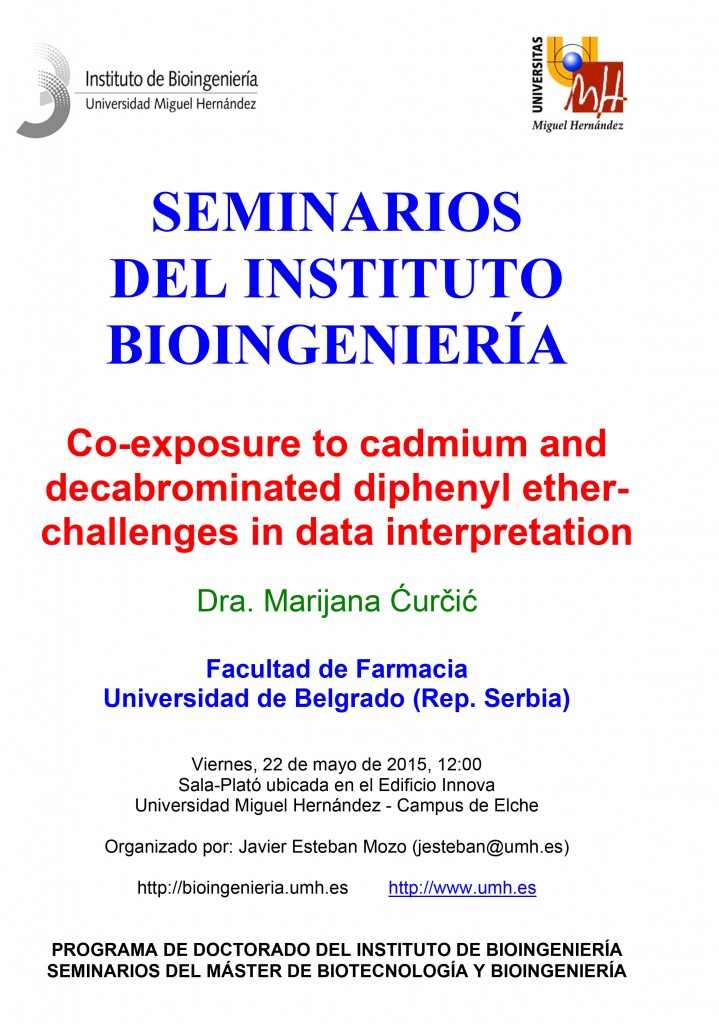 El Instituto de Bioingeniería (IB) de la Universidad Miguel Hernández de Elche (UMH) ha organizado el seminario ‘Co-exposure to cadmium and decabrominated diphenyl ether – challenges in data interpretation’. La científica Marijana Ćurčić mostrará los resultados de su investigación sobre la exposición simultánea a cadmio y el retardante de llama decabromo difenil éter. La actividad tendrá lugar el próximo 22 de mayo, a las 12 horas, en la Sala-Plató del edificio Innova de la UMH y se enmarca en los programas de la asignatura Seminarios en Biotecnología y Bioingeniería del máster y del Doctorado en Bioingeniería.
El Instituto de Bioingeniería (IB) de la Universidad Miguel Hernández de Elche (UMH) ha organizado el seminario ‘Co-exposure to cadmium and decabrominated diphenyl ether – challenges in data interpretation’. La científica Marijana Ćurčić mostrará los resultados de su investigación sobre la exposición simultánea a cadmio y el retardante de llama decabromo difenil éter. La actividad tendrá lugar el próximo 22 de mayo, a las 12 horas, en la Sala-Plató del edificio Innova de la UMH y se enmarca en los programas de la asignatura Seminarios en Biotecnología y Bioingeniería del máster y del Doctorado en Bioingeniería.
Marijana Ćurčić es profesora en la Facultad de Farmacia de la Universidad de Belgrado desde 1999. En 2007, recibió el premio Young Scientist Award por la International Union of Toxicology. La investigadora es miembro de diferentes asociaciones como ‘Pharmaceutical Society of Serbia’, ‘Serbian Society of toxicology’ y EUROTOX. Marijana Ćurčić ha colaborado con diversos ministerios de la República de Serbia para incorporar el Sistema Mundialmente Armonizado de Clasificación y Etiquetado de Productos Químicos (GHS) en la legislación Serbia y en la evaluación de riesgos de retardantes de llama polibromados, sobre lo que ha desarrollado su investigación. Actualmente, su campo de estudio comprende las interacciones entre sustancias químicas. En su presentación ‘Co-exposure to cadmium and decabrominated diphenyl ether – challenges in data interpretation’ nos mostrará los resultados obtenidos por la exposición simultánea a cadmio y el retardante de llama decabromo difenil éter.
Aquí os dejamos el abstract de la investigación de Marijana Ćurčić:
Toxicology of mixtures has come to the forefront of scientific community. Toxic metals and persistent organic pollutants are chemicals of great toxicological and ecotoxicological importance and can, under certain conditions, pose treat to human health and the environment. Co-exposure to Cd and BDE209, which are simultaneously present in the environment, can result in the development of toxic effects that are difficult to predict based on data obtained from the single substance studies. The aim of this seminar is to present challenges in data interpretation after subacute co-exposure to Cd and BDE-209 with focus on type of interactions. Male Wistar rats were administered Cd and BDE-209 according to OECD 407 guideline. Levels of Cd and BDE-209 in investigated organs were different after exposure to their mixture if compared to levels of these agents after exposure to single chemical pointing to interrelationship between these agents on the absorption level and the absorption rate in digestive tract and/or distribution in target organs of toxicity. Factorial regression analysis was used for determining the type of interaction while softvare PROAST was used to calculate the critical effect dose taking into account the dose of the second chemical as covariance. The results indicated higher toxic potential of Cd and BDE-209 mixture if compared to the potential of single toxic agents pointing to the necessity of further investigations in this field, especially in terms of the improvement of experimental model.
